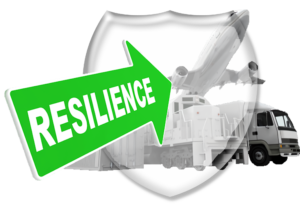When we describe the need for Enterprise Resilience Management, we often speak about the Complexity Gap — the gap between the complex, interconnected nature of today’s challenges and the ability of siloed, disconnected systems to respond. Enterprise Resilience Management is designed to close that gap.
For insight into the nature of the Complexity Gap and the need for resilience, it is not necessary to look any farther than the front page of today’s Wall Street Journal, which provides several snapshots of complexity in several different arenas (articles available online for subscribers only; worth tracking down in the print edition).
First and foremost, there’s the article about the growing terrorist threat to the global oil production and distribution system (“As Oil Supplies Are Stretched, Rebels, Terrorists Get New Clout,” by Chip Cummins, The Wall Street Journal, April 10, 2006, page A1). The article reports on a Nigerian rebel group that threatens and attacks local pipelines — with a direct impact on global petroleum prices:
The media-savvy guerrilla group’s emergence as a market mover points to a mounting problem for the U.S. and other big oil consumers: maintaining energy security in an era of scarce oil resources and ever-longer supply lines. With today’s tight oil markets, even small disruptions — or the threat of them — can jolt the world economy, leading to higher costs of gasoline, airline tickets and other goods for consumers everywhere….
That dynamic is giving new power to rebels, terrorists and ornery governments. Al Qaeda is targeting oil facilities in Saudi Arabia, the world’s No. 1 exporter. A foiled terrorist attack there helped send prices up more than $2 a barrel in February. Some Iranian officials have threatened to block the flow of oil from the Persian Gulf if the United Nations imposes sanctions over Tehran’s suspected nuclear-weapons program. Now even Mr. Gbomo’s small group, armed with little more than machine guns and an email account, has realized that it, too, can use oil as a weapon on the global stage.
A related article (“Oil Prices Show No Sign of Slowing,” by Bhushan Bahree, The Wall Street Journal, April 10, 2006, page A8) describes the already-fragile state of petroleum supply:
The fundamental trouble is that the global energy system for the past three years has been operating close to its ability to pump and refine crude. And with demand continuing to grow, output sagging in troubled oil regions and another hurricane season approaching, the industry has failed to restore a large cushion of spare capacity.
The petroleum supply chain is a prime candidate for Enterprise Resilience Management — at a variety of levels, from the local and tactical (automated security systems to defend key production facilities) to the global and strategic (automated processes that operate at a system-wide level to ensure continued production and distribution in the event of disruptions ranging from terrorist attacks to natural disasters). Daniel Yergin has written extensively on the need for improved energy security — a need that results from the complexity and interdependence of the supply chain (for our commentary on his recent Foreign Affairs article, with excerpts and links, click here). Yergin offers the beginning of a roadmap for a resilient energy supply chain that is responsive to today’s geopolitical realities.
Elsewhere in today’s Journal, a front-page article describes consumer reaction to the first RFID credit cards, designed to be remote-scanned by automated readers (“Why Some People Put These Credit Cards In The Microwave,” by Susan Warren, The Wall Street Journal,” April 10, 2006, page A1). As the title suggests, the reaction is not entirely positive:
…Mr. Walker, a 37-year-old software engineer in Canton, Ohio, is one of a growing number of computer and technology experts who are becoming anxious about possible abuses of the technology. Mr. Walker fears that thieves will be able to eavesdrop on the radio transmission and buy gas at his expense. He also figures that he himself could walk past the pump and accidentally pay for somebody else’s gas, though the card companies say he would have to get within two inches of the scanner to accomplish that feat.
In any event, he wants no part of it. Hammering the card destroyed the chip. “I tried it again and…nothing,” he says. “I might as well have been holding up a salami sandwich.”
The arrival of RFID credit cards reminds us, as does the example of the global energy supply chain, that complex systems are vulnerable at multiple points, and that current security systems may not be adequate to the new technology. Also at issue in this example is a related kind of gap — one that Tom Barnett calls a “rule-set gap.” Technology systems have outrun, not just security systems, but also social systems that govern public expectations and behaviors. Social rules lag behind technologic possibility.
On both counts, Enterprise Resilience Management can help. Automated security rules that govern trust, assurance and authentication in a networked, distributed payment environment will serve to protect the RFID credit card system from accidental and deliberate abuse, closing the Complexity Gap within the system itself. Enhanced trust and assurance will, in turn, answer the concerns of privacy advocates cited in the article, closing the rule-set gap between technology and society, and ensuring that RFID systems deliver their promised benefits.
Finally, the Journal reports on Disney’s plans to stream its most current television content over the Internet (“Disney Will Offer Many TV Shows Free On The Web,” by Brooks Barnes, The Wall Street Journal, April 10, 2006, Page A1). The distribution of entertainment content obviously does not have the economic or security implications of disruption in energy supply, or of transaction security. But the television content described here is one of Disney’s most critical assets, and protecting it in an era of multi-platform digital distribution is likely to tax Disney’s existing systems. Once again, automated processes, extended across multiple IT systems, and governing how and when the content can be used, will play a central role in protecting that content. Disney and other media companies, as well as their advertisers, will be protected from theft and abuse, and will be able to generate revenue from a variety of pricing and distribution options. Resilient systems will ensure that media companies continue to realize value from their content in a complex, vulnerable distribution environment.
Thanks to today’s Wall Street Journal, we can see — across industries, at different scales, and at different levels of criticality — that complexity is a truly pervasive challenge. And we can see that that challenge calls for a systemic response. The greater the interdependence and interconnectedness of systems and platforms, the greater the need for resilience.




